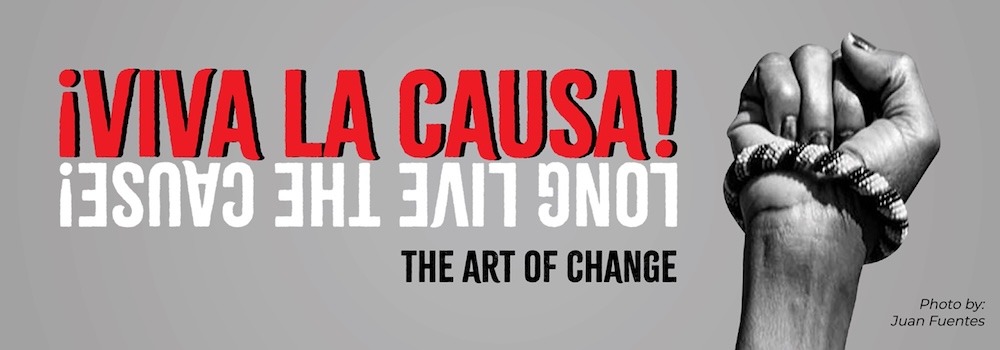While it may seem rhapsodic, almost mythical, there was a whole different movement percolating as the nation experienced the late sixties ‘Summer of Love.’ Back then the paradox of war and peace collided daily in headlines. But something else was germinating, almost stealth-like, but nonetheless taking hold.
As new words and expressions entered the lexicon, words like ‘body bag,’ ‘carpet bombing,’ ‘psychedelic,’ another was introducing itself. Chicano.
While ‘Chicano’ may have been new to the mainstream, to Mexican Americans it was as American as apple pie or menudo. And for the first time, people were taking notice and memorializing it, often times in art that adorned the walls of buildings, most often in Latino communities.
The art was a potpourri of emotions, ranging from anger to joy. It asked questions while providing a new look at a people long a part of the fabric but often ignored, unappreciated, marginalized.
“Definitely for my father,” said Lucha Martinez de Luna, Associate Curator of Latino History and Art at Denver’s History Colorado. De Luna’s father, Emanuel Martinez, was one of Colorado’s first Chicano muralists. His art, she said, depicted a history, sometimes painful and personal, experienced regularly by Latinos, so often shackled to what was then a ‘normalized’ second-class status in the land of equal- ity and opportunity.
¡Viva La Causa! Long Live the Cause!: The Art of Change, an exhibit of this Latino renaissance art movement is now on full display at Pueblo’s El Pueblo Museum. It will run through September.

Besides Martinez, painter and muralists Jodie Herrera, photographer Juan Fuentes and multi-media artist Floyd Tunson will also be featured. Beyond just paying homage to the Chicano movement, the exhibit will also have work that represents the Black Lives Matter movement.
To a lot of people, the only connection to the seismic power of the Chicano movement is through old, black and white film stock. This exhibit, intended to be more personal and intimate, said de Luna, “highlights the importance of artists during these social movements.” Like art throughout history, she said, it is the catalyst that influences, inspires and leads to change.
The exhibit, de Luna said, reflects the hardships, historical, often institutional mistreatment and ultimately triumphs of marginalized people. Her father, she said, while only one person, is the embodiment of all three.
“His childhood was very difficult,” she said. As a young boy, the combination of poor choices and often draconian and authoritarian enforcement of the law landed him in what was then Colorado’s only youth detention facility. He was thirteen.
While there, a nurse saw a nascent talent in a young Manuel’s art. Through this nurse’s encouragement, along with his ploy of finding a way to her office, Martinez kept his only slightly tapped talent burning.
“He would save matches,” de Luna said, and use the burned residue and “draw on paper towels.” His art and her encouragement lit the fuse on a talent that would only grow.
“There are many a¡rtists in this exhibit who have similar stories…who have been influenced and inspired to create change. They’re also activists.”
A number of murals created by Martinez and others can still be seen at various locations across Denver. But a lot of this period art—not only his but other artists whose work reflects the tumultuous period of the sixties and seventies—has disappeared, the victim of urbanization and gentrification. That is why, said de Luna, La Causa is so important. “It is full of sadness,” said the art curator and historian. “But that’s why it’s important for it to be recorded.”
The El Pueblo showing of ‘La Causa,’ is the second stop on this touring exhibit. It was recently shown at the Fort Garland Museum & Cultural Center where, said de Luna, it was well attended. “It was wonderful…a great showing,” she remembered. The Fort Garland showing also inspired a lot of “mixed emotions.” A number of people who saw the exhibit also shared their own experiences. “They’re descendants of this movement,” she said. Their connections were intimate.
The art and artists, working in a variety of mediums, are the sharing of emotions, said de Luna. They ask, “How do we express our frustrations and sorrows,” she said. These are the same questions artists have always asked. The art- ists, “become the mediators for us in finding consolation in recording this history.”
The exhibit, financed in part by the National Endowment for the Arts, opened on June 10th for its Pueblo showing. It runs through the end of September. The El Pueblo Museum is located at 301 N. Union Avenue and is open daily from 10:00 a.m. to 4:00 p.m. Admission is free for kids under 18 years of age.





